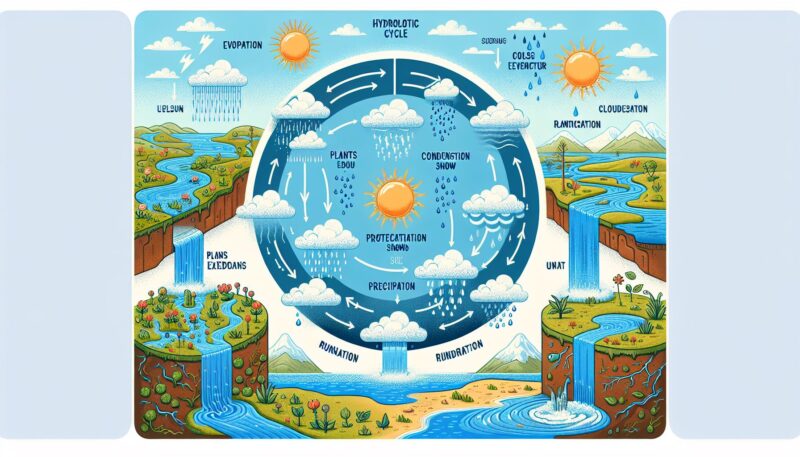The hydrologic cycle, also known as the water cycle, is a fundamental concept in hydrology, essential to all life on Earth. Through its continuous series of movements, water travels from the Earth’s surface to the atmosphere and back again, sustaining the planet’s ecosystems and facilitating various weather patterns and climate dynamics.
The hydrologic cycle is a complex, closed-loop system powered by the sun’s energy, driving water’s perpetual motion through various physical states and geographic locations, including rivers, lakes, oceans, atmosphere, and underground reservoirs. This comprehensive article will explore each stage of the hydrologic cycle, illustrate its significance to our planet, and discuss the implications for water quality, ecosystem health, and human usage.
Evaporation: The Ascent of Water Vapor
At the surface of water bodies—oceans, rivers, lakes, and even moist soil—water heats up from solar energy. When it reaches a certain temperature, the water molecules acquire enough energy to break free from liquid form and rise into the atmosphere as vapor, a process known as evaporation. Interestingly, plants also contribute to this atmospheric moisture through transpiration, where water evaporates from the surface of plant leaves.
Transpiration: The Hidden Stream
Transpiration is the lesser-known counterpart to evaporation. In thiskey, plants play a vital role by drawing water from the soil through their roots and releasing it as water vapor through microscopic pores on their leaves, called stomata. This invisible stream significantly contributes to the overall moisture transfer into the atmosphere.
Condensation: Crafting the Clouds
As water vapor rises and the ambient temperature drops, it undergoes condensation. The cooler temperatures at higher altitudes cause water vapor to change back into liquid form, creating clouds composed of tiny water droplets or ice crystals when temperatures are low enough.
Precipitation: Water’s Return to Earth
Precipitation occurs when these droplets grow too heavy to stay airborne, falling to the Earth’s surface as rain, snow, sleet, or hail. The distribution and type of precipitation are influenced by various atmospheric conditions, geographic location, and topography.
Infiltration and Percolation: Water’s Subterranean Journey
Upon reaching the ground, water begins its subterranean journey. Infiltration is the process by which water soaks into the soil, moving through the porous spaces between sediments. Percolation is the next stage, wherein water seeps further down, through the soil layer, reaching the groundwater systems.
Groundwater and Aquifers: The Hidden Reservoirs
Groundwater constitutes a significant portion of the Earth’s fresh water, residing in layers of soil, sand, and rock called aquifers. It moves much slower compared to surface water and can be stored for years, providing a stable supply during dry periods.
Springs and Baseflow: Groundwater’s Emergence
Groundwater naturally emerges at the Earth’s surface through springs or seeps, feeding into rivers and lakes. It also contributes to streams and rivers through baseflow, sustaining water levels especially during periods without rain.
Runoff and Streamflow: The Visible Path
Runoff is the portion of precipitation that doesn’t infiltrate or evaporate, traveling instead across the land’s surface towards larger bodies of water. This surface water collects in streams and rivers, a process known as streamflow, which eventually makes its way to lakes, estuaries, and oceans.
The Integral Role of Glaciers, Icebergs, and Snowpack
Frozen water found in glaciers, icebergs, and snowpack also plays a crucial role in the hydrologic cycle. They act as long-term storage for freshwater, and their seasonal melt contributes to rivers and streams, affecting water availability downstream.
Human Impacts on the Hydrologic Cycle
Human activities have a profound impact on the water cycle. Urbanization increases impermeable surfaces, altering runoff patterns and potentially leading to increased flooding. Agriculture can modify transpiration rates, and water withdrawals for industry and consumption can reduce surface water and groundwater levels.
Water Quality and Pollution
Water quality is pivotal in determining the health of ecosystems and the suitability of water for human use. Pollution from chemicals, nutrients, pathogens, and microplastics can adversely affect water at every stage of the hydrologic cycle, with serious ramifications for all living organisms.
Climate Change and the Hydrologic Cycle
Climate change is altering the hydrologic cycle in significant ways, affecting the distribution and intensity of precipitation, accelerating the melting of ice and snow, and increasing evaporation rates. These changes can lead to more extreme weather events like droughts and floods, which have dire consequences for habitats, agriculture, and human settlements.
The Necessity of Water Management
Given the finite nature of freshwater resources and the growing demand, effective water management practices are essential. This involves water treatment processes such as reverse osmosis, chlorination, and ozonation; water distribution systems; and conservation strategies like rainwater harvesting and greywater reuse.
Conclusion
The hydrologic cycle is a testament to the dynamic nature of water on our planet. Understanding its many phases and the factors that influence it is crucial for managing our water resources sustainably and ensuring the survival of diverse life forms on Earth. As climate change and human activities present new challenges to this delicate system, a focus on science and policy is more important than ever to maintain the balance of this invaluable cycle.
Sources
- “The Water Cycle.” United States Geological Survey (USGS). https://www.usgs.gov/special-topic/water-science-school/science/water-cycle
- “Climate Change: Global Sea Level.” NASA. https://climate.nasa.gov/vital-signs/sea-level/
